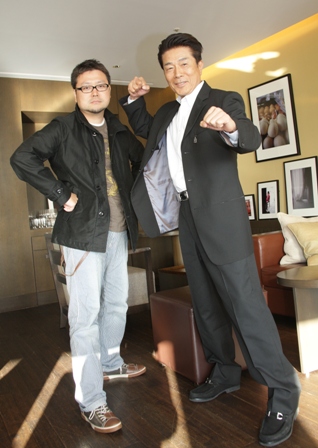Japanese Eyes “Monster Killer” Interview with Yasuaki Kurata (Development/Producer/Right)and Takanori Tsujimoto (Director/Left)

The titles of Japanese movies, horror movies in particular, tend to be vague (“The Grudge,” “The Ring”), so “Monster Killer” sounds refreshingly specific, if a bit generic. Nevertheless it isn’t the final title of the action-horror hybrid that played at this year’s TIFF.
“We had to come up with something quickly for the festival,” says Yasuaki Kurata, the film’s producer and one of its stars. The Japanese title translates as “Red Tears,” but Kurata says for overseas distribution they’ve hit on the English title “Sword of Blood,” which is not so much vague as misleading.
Kurata is a Japanese action star with a solid reputation in Asia, mainly Hong Kong where he first worked in the late 1970s. He and his production company came up with the idea of “Monster Killer” and developed it into a finished movie. “From the start I wanted it to be an action film with a female protagonist,” he says. “Then I decided I wanted something more, and the first thing I thought about was vampires.”
The “monster” in the movie isn’t strictly a vampire. The basic idea, in fact, borrows from several pulp genres. “Monster Killer” starts out as serial killer/slasher film, with a scared young man being attacked in a dark tunnel by an unknown assailant. In one of the movie’s more imaginative touches, the victim is then literally folded up–still alive–and packed into a suitcase. The shadowy assailant then wheels him to the proverbial damp, dirty dungeon where he is beheaded in a suitably theatrical fashion.
Kurata says “Monster Killer” is his first horror movie, which is why he hired Takanori Tsujimoto to direct. Tsujimoto demurs on the label “horror director,” however. His genre, he insists, is “violence.”
“In ‘violence’ movies there’s a story, a narrative, and within the story there are violent scenes,” he explains. “‘Horror’ movies are more intentional. You actually start with the horror elements and then build the storyline around it.” Apparently, in this case, Kurata gave Tsujimoto the things he wanted–vampires, female protagonists, opportunities for extended action fight scenes–and asked him to build a story around it.
The writer, Eiichi Yonekawa, developed a tale about two police detectives in a Tokyo suburb, one young and idealistic (Yuma Ishigaki), the other experienced, cynical, and independent (Kurata) who are both trying to catch the serial killer. Within this framework Tsujimoto indulged his own preference for filling the screen with as much fake blood as possible. “Maybe I dragged Kurata-san in that direction,” he admits. “And I don’t know if it was the right decision or not. Some will say it’s overdone.”
The duality is exaggerated when the younger policeman, Tetsuo, falls in love with the woman who the older policeman, Mishima, suspects is directly involved in the killings. Tetsuo wants to catch the killer in the conventional way, but Mishima has been fighting this sort of evil for a long time, and has himself taken on some of the bloodthirsty attributes of his enemy.
“He isn’t a hero,” Kurata says about his character. “He wants revenge, and he knows he has to be evil to fight these monsters.”
So does that make Tetsuo the hero?
“That’s a tricky question,” says Tsujimoto. In the classic good-vs-evil world that the movie embodies, Tetsuo is a bit too soft and sentimental. “I told the actor who plays Tetsuo that he isn’t really a likable character,” says the director. “In the past you wouldn’t call him a hero. The point is to provide contrast with Mishima. That’s what propels the story.”

Nevertheless, the movie is built around its action set pieces, almost all of which feature Kurata and include a bit of wire work. When asked about the Hong Kong influence, Kurata says, “Hong Kong films are about over-action, or overdoing it; whereas Japanese action is often too subtle. It doesn’t satisfy the audience in the same way. I prefer Hong Kong style myself, but keep in mind that wire work was not used in Hong Kong until ‘Chinese Ghost Story’ (1987). My production company introduced wire action to Japanese films, about nine years ago, in a film called ‘Yellow Dragon’.”
In any event, the best word to describe the movie’s special effects is “analog.” The production values copy those of so-called Kaburi-mono productions, which are enjoying a revival right now. “Kaburu” means “to wear” and refers to costumed sci-fi superheroes and villains that were popular on Japanese TV in the late 60s and 70s, when most of today’s genre directors, like Tsujimoto, grew up. “When you see the masked figure emerging from the dark,” the director explains, “it’s really thrilling.” Nevertheless, he admits that he believes Kurata “had some doubts” about this aspect of the direction while they were shooting the movie.
Kurata says he had no trouble with Tsujimoto’s “taste,” and, in any case, the production values had more to do with “budget constraints” than personal artistic vision.
“To be honest, if I had the budget I would make every scene with computer graphics,” Kurata adds. “But I’m an action actor, which means my feet are on the ground. And we agreed that since martial arts were an important part of the movie it should be analog. But it would have been great to do it Hollywood style.”
Interviewed by Philip Brasor (Film writer)
Monster Killer












